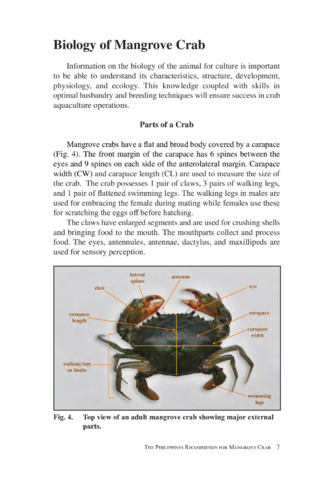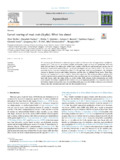Soft-shell crab production using hatchery-produced mangrove crab Scylla serrata juveniles
| dc.contributor.author | Ganesh, K. | |
| dc.contributor.author | Dinakaran, G. K. | |
| dc.contributor.author | Sundaresan, T. | |
| dc.contributor.author | Satheesh Kumar, K. | |
| dc.contributor.author | Gangadharan, K. V. | |
| dc.contributor.author | Viswanathan, S. | |
| dc.contributor.author | Pandiarajan, S. | |
| dc.contributor.author | Thampi Sam Raj, Yohannan C. | |
| dc.contributor.editor | Quinitio, Emilia T. | |
| dc.contributor.editor | Estepa, Fe Dolores P. | |
| dc.contributor.editor | Thampi Sam Raj, Yohannan C. | |
| dc.contributor.editor | Mandal, Anup | |
| dc.date.accessioned | 2017-09-04T10:09:19Z | |
| dc.date.accessioned | 2017-09-04T10:40:20Z | |
| dc.date.accessioned | 2017-09-05T08:48:52Z | |
| dc.date.available | 2017-09-04T10:09:19Z | |
| dc.date.available | 2017-09-04T10:40:20Z | |
| dc.date.available | 2017-09-05T08:48:52Z | |
| dc.date.issued | 2015 | |
| dc.identifier.citation | Ganesh, K., Dinakaran, G. K., Sundaresan, T., Satheesh Kumar, K., Gangadharan, K. V., Viswanathan, S., … Thampi Sam Raj, Y. C. (2015). Soft-shell crab production using hatchery-produced mangrove crab Scylla serrata juveniles. In E. T. Quinitio, F. D. Parado-Estepa, Y. C. Thampi Sam Raj, & A. Mandal (Eds.), Proceedings of the International Seminar-Workshop on Mud Crab Aquaculture and Fisheries Management, 10-12 April 2013, Tamil Nadu, India (pp. 101-106). Tamil Nadu, India: Rajiv Gandhi Centre for Aquaculture (MPEDA). | en |
| dc.identifier.isbn | 9788192989815 | |
| dc.identifier.uri | http://hdl.handle.net/10862/3216 | |
| dc.description.abstract | Soft-shell crab production is being practiced in many Asian countries but the major source of seedstock is from the wild, which could no longer sustain the increasing demand. Commercial scale soft-shell crab production can become sustainable only if there is a continuous supply of seedstock not dependent on wild stock. Rajiv Gandhi Centre for Aquaculture (RGCA) under the Marine Products Export Development Authority (MPEDA) has established a pilot-scale mud crab hatchery at Thoduvai, Nagapattinam District, Tamilnadu in 2004 with the technical assistance from SEAFDEC/AQD. At present, RGCA has the biggest mud crab hatchery in India and a demonstration farm at Karaikal, U.T. of Puducherry, where nursery rearing, grow-out and soft-shell crab production are conducted using hatchery- produced mangrove crabs or mud crabs, Scylla serrata. This paper presents the results of the soft-shell crab production using hatcheryproduced S. serrata juveniles maintained in perforated low density polyethylene (LDPE) boxes. The duration of the molt interval, time of molt (day or night) and the increase in body weight and carapace width of each size group (40-60, 61-80, 81-100, 101-120, 121-140, 141-160, 161-180 g) after molting were determined. Results showed that the percentage increase in body weight and carapace width increased as the crabs grew bigger. Likewise, the molt interval was longer in bigger-sized groups of crabs. Sixty to seventy percent of the population molted during night time and the next molt occurred within 25 days in 80-160 g size groups. Soft-shell crabs in boxes within the water surface and juvenile crabs (2.5 cm CW initial size) for culture until market size in the pond can be a viable technology technology for mud crab growers. | en |
| dc.language.iso | en | en |
| dc.publisher | Rajiv Gandhi Centre for Aquaculture (MPEDA) | en |
| dc.subject | Scylla serrata | en |
| dc.subject | Mud crab | en |
| dc.subject | RGCA | en |
| dc.subject | Soft shell | en |
| dc.subject | Plastic boxes | en |
| dc.subject | Two tier operating system | en |
| dc.title | Soft-shell crab production using hatchery-produced mangrove crab Scylla serrata juveniles | en |
| dc.type | Conference paper | en |
| dc.citation.spage | 101 | |
| dc.citation.epage | 106 | |
| dc.citation.conferenceTitle | Proceedings of the International Seminar-Workshop on Mud Crab Aquaculture and Fisheries Management, 10-12 April 2013, Tamil Nadu, India | en |
| dc.subject.asfa | moulting | en |
| dc.subject.scientificName | Scylla serrata | en |
Files in this item
| Files | ขนาด | รูป | View |
|---|---|---|---|
|
There are no files associated with this item. |
|||
รายการนี้ปรากฏใน (s)
-
International Seminar-Workshop on Mud Crab Aquaculture and Fisheries Management (ISMAF 2013) [15]
Proceedings of the International Seminar-Workshop on Mud Crab Aquaculture and Fisheries Management, 10 - 12 April 2013




